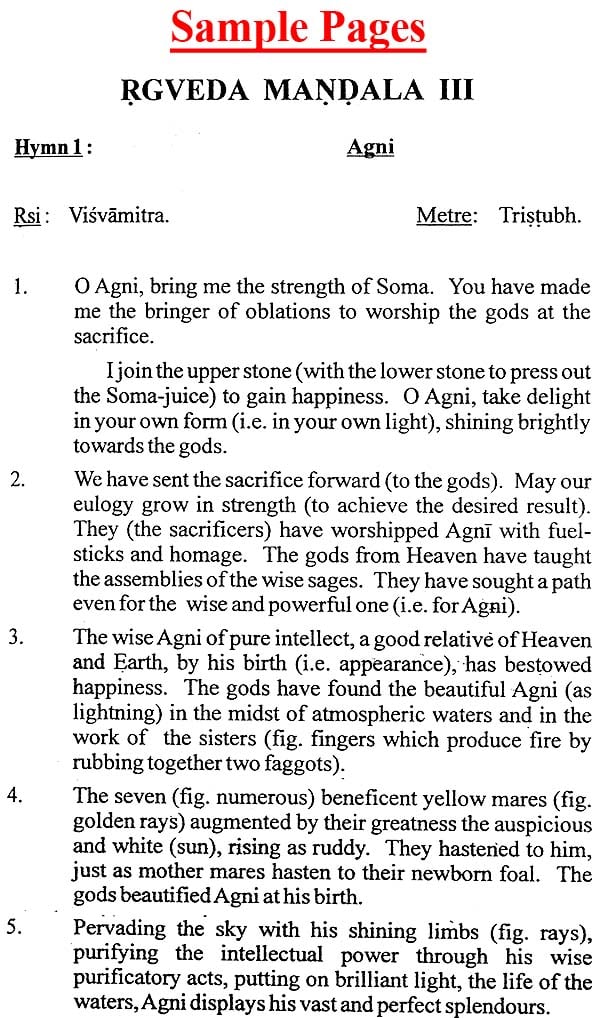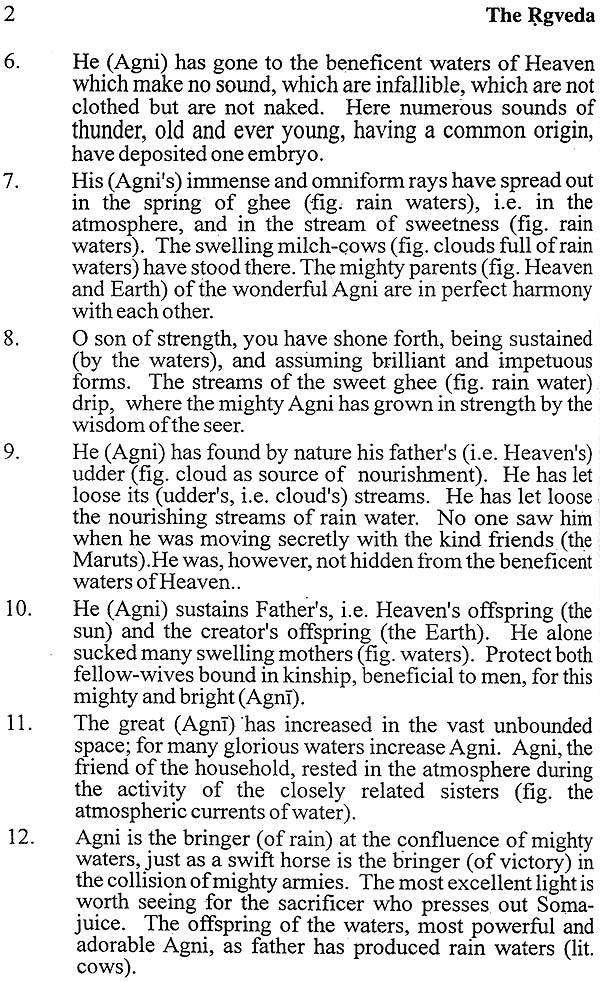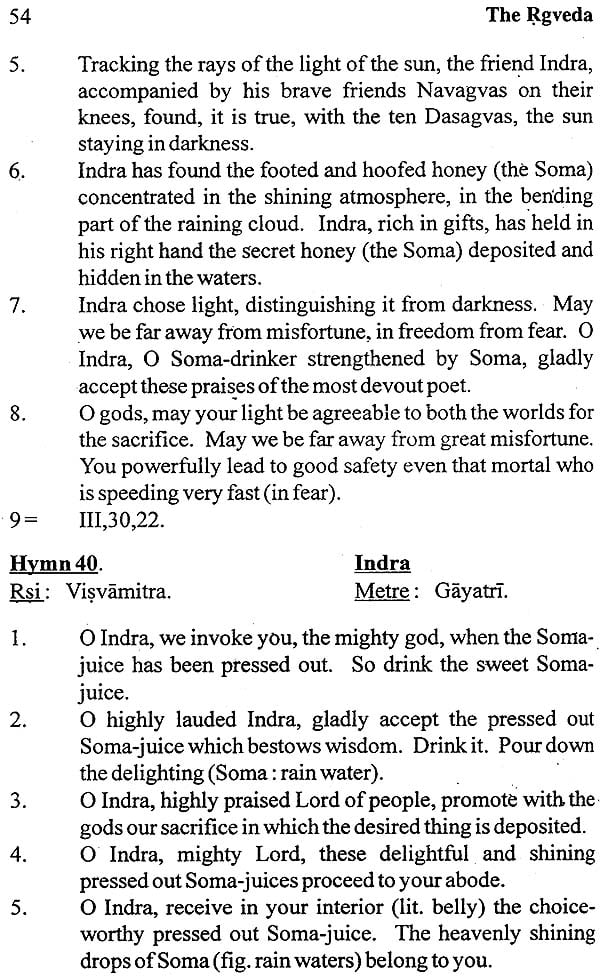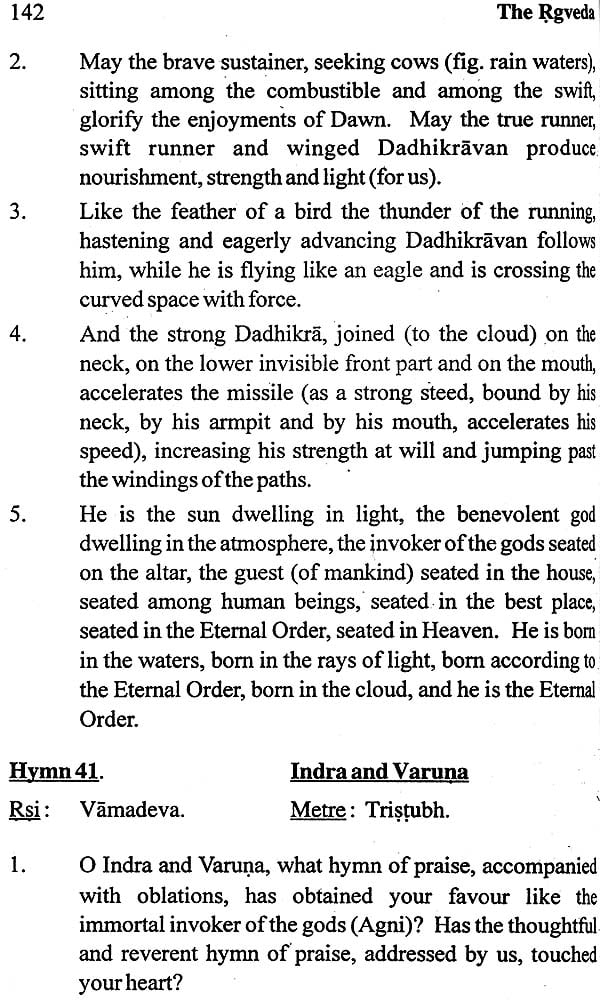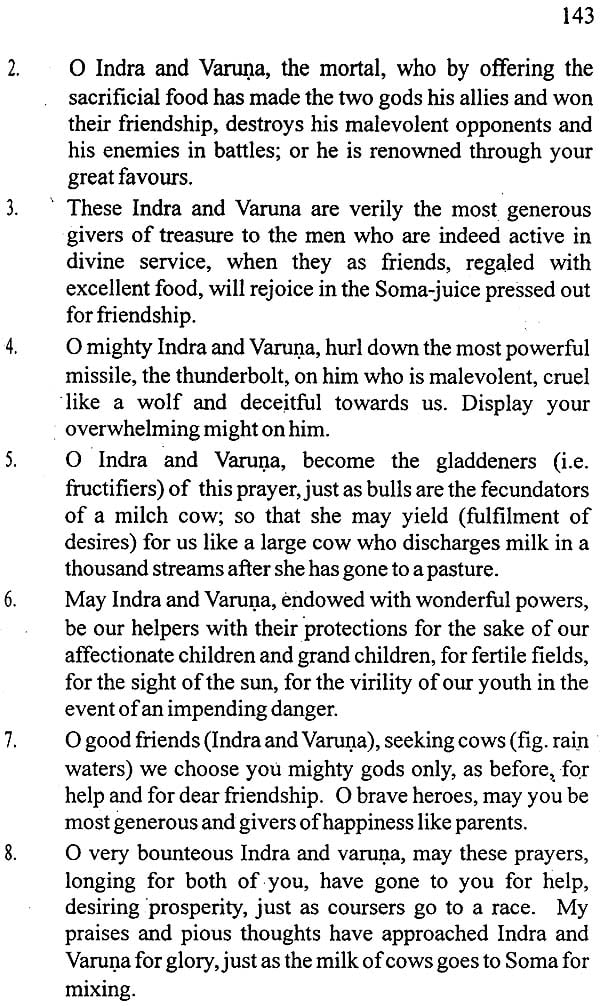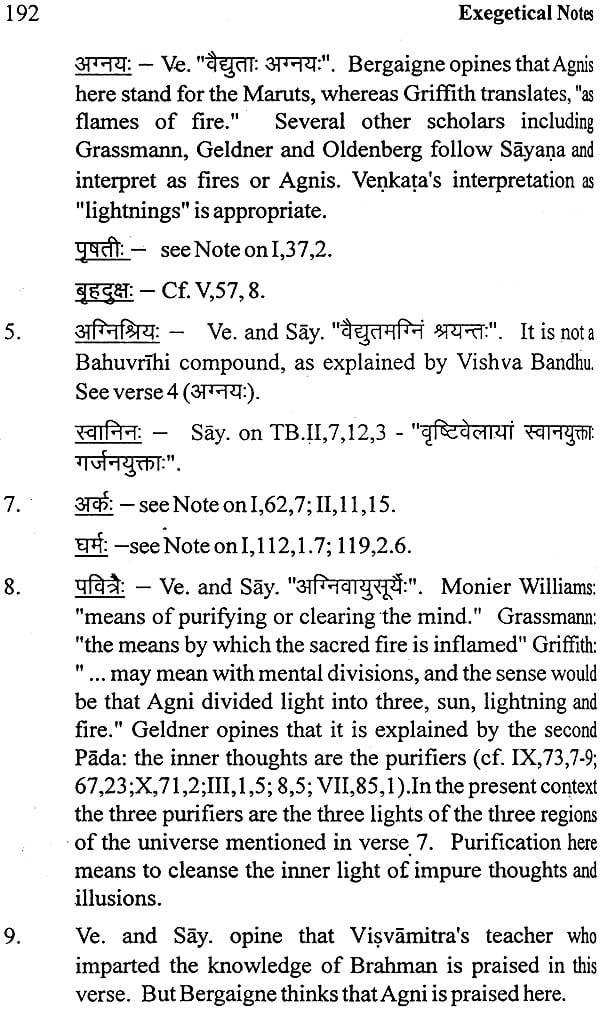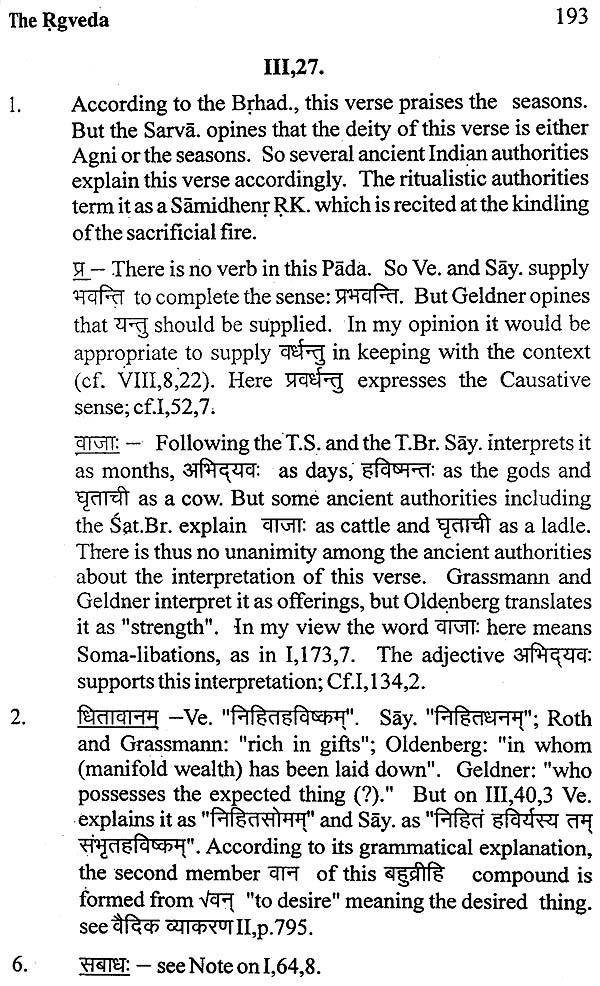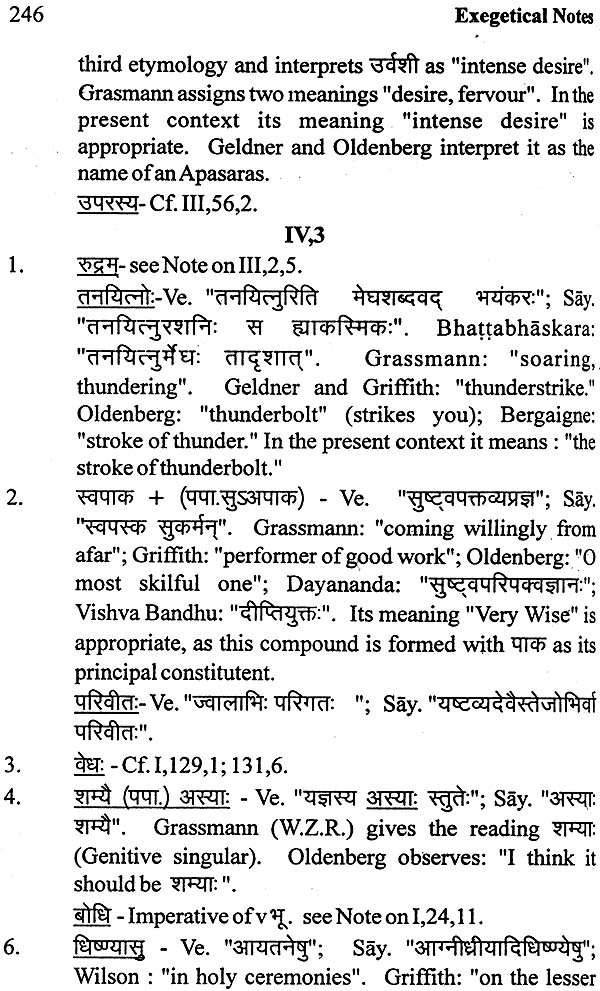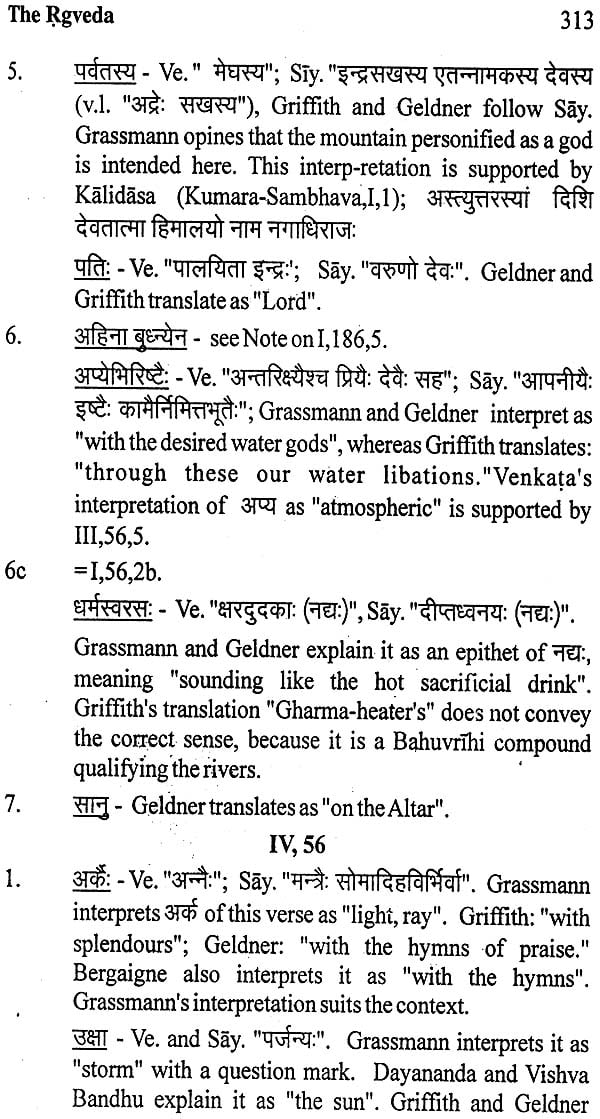
The Rgveda - Interpreted and Translated with a Review of Important Interpretations Ancient and Modern (Vol-III)
Book Specification
| Item Code: | NAN169 |
| Author: | Ram Gopal |
| Publisher: | Vishveshvaranand Vedic Research Institute, Hoshiarpur |
| Language: | English |
| Edition: | 2011 |
| Pages: | 327 |
| Cover: | Hardcover |
| Other Details | 9.0 inch X 5.5 inch |
| Weight | 420 gm |
Book Description
The present Volume blazes a new trail in the interpretation of the Rgveda. the oldest and outstanding work of world literature which has influenced the religion. Philosophy, Law, literature and culture of India. In order to dispel the confusion and misconceptions arising from the diversity of arbitrary and inconsistent commentaries and translations of this sacred text, the present author has presented a lucid consistent and rational translation of the Rgveda with a critical review of important interpretations ancient and modern after a thorough and minute examination of all the relevant Vedic passages. In his interpretation the author follows the guiding principle that the Veda must shine with its own light, without any prejudice or predilection. In the Exegetical Notes appended to the Translation the author refers to the divergent views of the ancient Indian commentators and modern Vedic scholars on the interpretation of obscure and rare Rgvedic words together with his own conclusions on the subject. Besides the doubtful grammatical forms of the relevant Rgvedic words have also been discussed in the Notes.
Professor Ram Gopal, a former Vice- Chancellor of M.D. University, Rohtak and formerly Kalidasa Professor of Sanskrit and Head of the Department of Kalidasa Chair, Panjab University, Chandigarh, is an eminent Sanskrit scholar of international repute. He is an acknowledged authority on the Vedic language, literature and culture. His outstanding and original research works which include India of Vedic Kalpa-Sutras, Vaidika Vyakarana (in two volumes),Vaidika- Vyakhya- Vivechana, Vedartha-Vimarsa, The History and Principles of Verlic Interpretation, Kalidasa: His Art and Culture, The Vedic Language and Exegesis, Vedic heritage have been highly appreciated by the renowned scholars of Sanskrit and Indology all over the world. In recognition of his outstanding contributions to the realm of Sanskrit studies he was awarded the Independence Day Award, Certificate of Honour in Sanskrit, by the President of India in 1971. And the same year he was honoured by the Haryana Government also with the State literary Award in Sanskrit and a Felicitation Volume. The Ministry of Education and Culture, Government of India, awarded him a literary Prize of Rs. 10,000 in 1981 in appreciation of his reputed research work Vaidika Vyakarana (in two Volumes). He was honoured by Maharshi Sandipani Rashtriya Veda-Vidya Pratishthana Ujjain with a Citation and a Cash Award in 2003. He has chaired several seminars, symposia and conferences connected with Vedic studies. He was the President of the Vedic section f the All India Oriental Conference held in 1966.
The Volume In comprises the translation and interpretation of Mandalas III and IV ascribed to the families of Visvamitra and Vamadeva respectively.
It is abundantly clear from a study of Mandala III that the seers of this Mandala are well acquainted with the region lying between the rivers Sutudri (Satluj) and Sarasvati. The hymn 33 of the third Mandala contains a dialogue between the seer Visvamitra and the rivers Vipas (Beas) and Eutudri (Satluj). Visvamitra first praises these rivers as mothers and then implores them to be fordable so that he may cross them with his carts, chariots and with his followers Bharatas. The rivers grant his request and he thanks them.
The hymn 23 of the Third Mandala points to the fact that the Bharatas were at that time settled in the region which was later called Kuruksetra; for this hymn alludes to the sacrifice performed by the two Bharatas Devasravas and Devavata on the banks of the rivers Drsadevati, Apaya and Sarasvati and at the Manusa lake of the Kuruksetra region.
The above-mentioned rivers and the lake are eulogised in the Mahabharata, The Mbh. (IIl,83,4) describes the region lying between the Sarasvati and the Drsadvati as Kuruksetra. Praising the lake Manusa and the river Apaga, which is undoubtedly the river Apaya of the RV., the Mbh. (IIl,83,65- 68) declares : 'O Lord of Kings, one should then go to the universally renowned Manusa where, O King, black antelopes, pierced with arrows by a hunter, attained manhood, after plunging into it. After having ablutions at that Tirtha, a celibate and devout man is purged of all sins and is glorified in Heaven. To the east of Manusa at a distance of just one Krosa flows, 0 King, the river Apaga which is frequented by the Siddhas.
The close connection between Visvamitra and the Bharatas is evident from llI,33,12 where it is stated that the Bharatas crossed the Beas and the Satluj with Visvamitra, Visvamitra's close association with the Bharatas is further demonstrated by llI,53,12 which says that the prayer of Visvamitra protects the Bharatas.
It appears that the Bharatas, who were at that time settled in the Kuruksetra regions, later merged with the Kurus who wielded power in the Kuruksetra region. So a descendant of the Kuru family is often addressed as Bharata in the Mbh.
A verse of Mandala III (III,62,1O), addressed to Savitri, is the famous Savitri Rk which is highly eulogised in Vedangas and the Smrtis, as it is composed in the Gayatri metre, it is also called Gayatri Mantra. According to the Vedangas, this Savitri Rk must be recited at the beginning of Vedic studies. The Smrtis prescribe the recitation of this Savitri Rk for the expiation of various sins. This sacred verse forms an essential part of the daily prayer of the devout Hindus.
The only geographical information available from the fourth Mandala is the mention of the river Sarayu (IV,30, 18). RV. V,53,9 mentions the Sarayu along with the six well-known rivers of the North- West, viz. Rasa; Anitabha, Kubha, Krumu, Sindhu and Purisini, It is quite clear that the Sarayu is a river of the North-Western part of the Indian Sub-continent. See NoteonIV,30,18.
The misinterpretation of IV, 18, 13 has led the ancient and modem scholars to draw wrong conclusions. So the Manu- Smriti (X,106) says; "Vamadeva, who well knew right and wrong, did not sally himself when tormented (by hunger) he desired to eat the flesh of a dog to save his life." The Brhad, (IV,126) remarks: "When he (Vamadeva) cooked the entrails of a dog to worship the gods, seers and the Pitrs, Indra in the form of an eagle brought sweet Soma for him."
The confusion about the meaning of this verse has arisen because of its wrong interpretation. It may be pointed out in this connection that the speaker in this verse is Indra and not Vamadeva. Secondly, the word Svan in the present context denotes the star Canis Major and not an animal dog. Moreover, the word Syena (eagle) figuratively denotes lightning. For further details see the Exegetical Note on this verse.
The 57th hymn of the Fourth Mandala is devoted to agriculturist. So in this hymn prayers are made to five agricultural deities, viz. Ksetrapati, Suna, Sunasirau and Sita for good crops, for the happiness and welfare of plough- drawing oxen and ploughmen and for the happiness and prosperity of all concerned with agriculture.
I thank Prof. I. D. Uniyal for his active co-operation in the publication of this work.
I am thankful to Prof. T.S. Bindra for reading the proofs with great care.
Contents
| Preface | i-iii |
| Mandala-III | 1-83 |
| Mandala-IV | 84-161 |
| Exegetical Notes | 162-319 |
